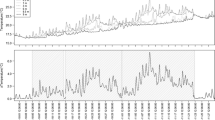Abstract
P, Fe, Mn, and S species were analyzed in water samples from the sediment-water interface collected at four seasonally different times during the course of a year at two sampling sites in the southern basin of Lake Lugano (Lago di Lugano). The results reveal the strong influence of the biogeochemical processes in the sediment on the chemical composition of the lake water above. Consumption of oxygen and nitrate under oxic to microoxic conditions in the water column as well as sequential release of reduced manganese and iron under anoxic conditions was observed as a direct or indirect consequence of microbially mediated degradation of organic matter. The seasonal pattern observed for the release and the retainment of dissolved reduced iron and manganese correlates well with the one for dissolved phosphate. Iron, manganese and phosphorus cycling are coupled tightly in these sediments. Both sediment types act as sinks for hydrogen sulfide and sulfate. An inner-sedimentary sulfur cycle is proposed to couple iron, manganese and phosphorus cycling with the degradation of organic matter. Nutrient cycling at the sediment-water interface might thus be driven by a microbially regulated “electron pum**” mechanism. The results contribute to a better understanding of the role of sediment processes in the lake's internal phosphorus cycle and its seasonal dynamics.
Similar content being viewed by others
References
Baccini, P., 1985. Phosphate interactions at the sediment-water interface. In: W. Stumm (ed.), Chemical processes in lakes, John Wiley & Sons, Inc., New York, pp. 189–205.
Berner, R. A., 1980. Early diagenesis. A theoretical approach, Princeton University Press, Princeton, 237 pp.
Brandl, H., 1987. Mikrobielle Prozesse unter Oxidationsmittel-limitierten Bedingungen an der Sediment-Wasser-Übergangszone in Seen. Dissertation, University of Zurich, Switzerland.
Brandl, H. and K. W. Hanselmann, 1991. Evaluation and application of dialysis porewater samplers for microbiological studies at sediment-water interfaces. Aquatic Sci. 53:55–73.
Brandl, H., K. W. Hanselmann and R. Bachofen, 1990. In situ stimulation of bacterial sulfate reduction in sulfate-limited freshwater lake sediments. FEMS Microbiol. Ecol. 74:21–32.
Brandl, H., K. W. Hanselmann, R. Bachofen and J. Piccard, 1992. Methods for the collection of porewater, sediment near bottom water, and sediment cores from deep freshwater lake sediments with the manned research submarine “F.-A. Forel”. In preparation.
Burdige, D. J. and K. H. Nealson, 1986. Chemical and microbiological studies of sulfide-mediated manganese reduction. Geomicrobiol. J. 4:361–387.
Gächter, R., 1987. Lake restoration. Why oxygenation and artificial mixing cannot substitute for a decrease in the external phosphorus loading. Schweiz. Z. Hydrol. 49:170–184.
Gächer, R., J. S. Meyer and A. Mares, 1988. Contribution of bacteria to release and fixation of phosphorus in lake sediments. Limnol. Oceanogr. 33:1542–1558.
Gilboa-Garber, N., 1971. Direct spectrophotometric determination of inorganic sulfide in biological materials and in other complex mixtures. Anal. Biochem. 43:129–133.
Hanselmann, K. W., 1986. Microbially mediated processes in environmental chemistry (lake sediments as model systems). Chimia 40:146–159.
Hanselmann, K. W., 1989. Rezente Sedimente, Lebensräume für Mikroorganismen. Die Geowissenschaften 7:98–112.
Hanselmann, K. W., 1991. Microbial energetics applied to waste repositories. Experientia 47:645–687.
Hanselmann, K. W., M. Lazzaretti, H. Brandl and R. Bachofen, 1990. Mikrobiell regulierte Eisenrücklösung, gekoppelt mit Nährstoffzyklisierung in Sedimenten des Ceresio (Lago di Lugano). International Symposium on Limnological Aspects and Management of the Lake of Lugano. Lugano.
King, G. M., 1990. Effects of added manganic and ferric oxides on sulfate reduction and sulfide oxidation in intertidal sediments. FEMS Microbiol. Ecol. 73:131–138.
Laboratorio Studi Ambientali (LSA), 1991. Ricerche sull'evoluzione del Lago di Lugano; aspetti limnologici. Campagna 1989. Ed.: Commissione Internazionale per la Protezione delle Acque Italo-Svizzere.
Lovley, D. R., 1991. Dissimilatory Fe(III) and Mn(IV) reduction. Microbiol. Rev. 55:259–287.
Lovley, D. R., and E. J. P. Phillips, 1988a. Novel mode of microbial energy metabolism: organic carbon oxidation coupled to dissimilatory reduction of iron or manganese. Appl. Environ. Microbiol. 54:1472–1480.
Lovley, D. R. and E. J. P. Phillips, 1988b. Manganese inhibition of microbial iron reduction in anaerobic sediments. Geomicrobiol. J. 6:145–155.
Lovley, D. R., J. F. Stolz, G. L. Nord and E. J. Phillips, 1987. Anaerobic production of magnetite by a dissimilatory iron-reducing microorganism. Nature (London) 330:252–254.
Murphy, J. and J. P. Riley, 1962. A modified single solution method for the determination of phosphate in natural waters. Anal. Chim. Acta 27:31–36.
Myers, C. R. and K. H. Nealson, 1988. Microbial reduction of manganese oxides: interactions with iron and sulfur. Geochim. Cosmochim. Acta 52:2727–2732.
Nedwell, D. B., 1982. The cycling of sulphur in marine and freshwater sediments. In: D. B. Nedwell and C. M. Brown (eds.), Sediment microbiology, Academic Press, Inc., London, pp. 73–106.
Niessen, F., 1987. Sedimentologische, geophysikalische und geochemische Untersuchungen zur Entstehung und Ablagerungsgeschichte des Luganersees (Schweiz). Dissertation, ETH Zurich, Switzerland.
Polli, B., A. Barbieri and M. Simona, 1990. Produzione algale e sedimentazione nel Lago di Lugano: misure sperimentali e loro utilizzo in un modello dinamico. International Symposium on Limnological Aspects and Management of the Lake of Lugano. Lugano.
Rickard, D. T., 1974. Kinetics and mechanism of the sulfidation of goethite. Am. J. Sci. 274:941–952.
Sigg, L. and W. Stumm, 1989. Aquatische Chemie, Verlag der Fachvereine Zürich, Zürich, pp. 388.
Stumm, W. and J. J. Morgan, 1981. Aquatic Chemistry, John Wiley & Sons, Inc., New York, 780 pp.
Wersin, P., P. Höhener, R. Giovanoli and W. Stumm, 1991. Early diagenetic influences on iron transformations in a freshwater lake sediment. Chem. Geol. 90:233–252.
Zinder, B. and W. Stumm, 1985. Die Auflösung von Eisen(III)-oxiden; ihre Bedeutung im See und im Boden. Chimia 39:280–288.
Author information
Authors and Affiliations
Rights and permissions
About this article
Cite this article
Lazzaretti, M.A., Hanselmann, K.W., Brandl, H. et al. The role of sediments in the phosphorus cycle in Lake Lugano. II. Seasonal and spatial variability of microbiological processes at the sediment-water interface. Aquatic Science 54, 285–299 (1992). https://doi.org/10.1007/BF00878142
Received:
Accepted:
Issue Date:
DOI: https://doi.org/10.1007/BF00878142




